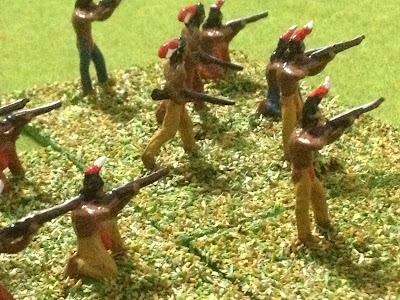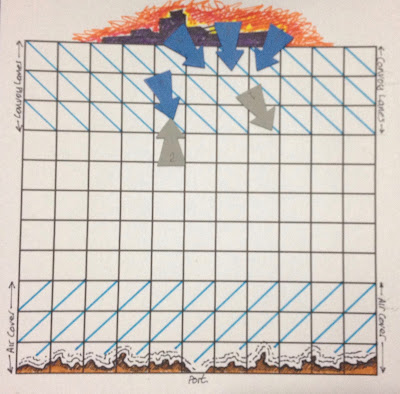Having played the first game of the campaign, a small opening engagement, the dice determined the next game was to be a pitched battle.
Unfortunately I managed to delete all bar one of my photos of the game. Doh! So the one picture I retained is below.
 |
| The final turn before the Ustrorian forces retired |
The forces involved:
Greater Novia
- 5 x Infantry units
- 1 x Skirmisher unit
- 1 x Cavalry
- 1 x Dragoon
- 2 x Artillery
Unfortunately only 8 units were to be available. One of the artillery units and a cavalry unit became bogged and did not arrive.
Ustrorian
6 x Infantry units
1 x Skirmisher unit
1 x Cavalry unit
2 x Artillery units
While being able to field all 10 units. Three units, one infantry, artillery and cavalry were delayed until turn 5.
The battle was won by the Novian army after the Ustrorian army retired with the loss of 5 units. Novian lost 3 units during the engagement. However, there were some memorable moments in the game which were to play out in the newspapers.
The Novian Courier...
Breaking news - Greater Novian forces were victorious today! Few casualties are reported.
The Ustrorian Times...
Ustrorian forces put up a brave defence against overwhelming Novian forces. Acts of valour ruled the day. Our gallant infantry retook the town of Sillanburg after some fierce fighting, and our bare cavalry men who charged down attackers as they fled. However, the battle was not without price, with many of our brave Ustrovian lads laying down their lives.
The public opinion now stands at:
Greater Novia - Reduced from 45% to 40%
3 units lost, but 2 rolled more than 4+ and were saved. So minus 5%.
Ustroria - Reduced from 40% to 35%
Glorious action plus 5%
Past Glories plus 5% for a successful cavalry charge
5 units lost, but 2 rolled more than 4+ and were saved. Minus 15%.
Total is minus 5%
Given the lack of photos, here is one of two units British line infantry recently painted for my French Indian wars project. My aim is to try and complete two units each week.
 |
| Completed this past weekend |










































